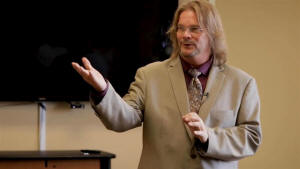EDUCATOR SHORTAGES: Survey: Illinois schools face worsening educator
shortage
 Send a link to a friend
Send a link to a friend
[January 19, 2022]
By PETER HANCOCK
Capitol News Illinois
phancock@capitolnewsillinois.com
 SPRINGFIELD – School officials across
Illinois say a shortage of teachers and substitutes is forcing them to
cancel course offerings, move them online or fill open positions with
people who are not fully qualified. SPRINGFIELD – School officials across
Illinois say a shortage of teachers and substitutes is forcing them to
cancel course offerings, move them online or fill open positions with
people who are not fully qualified.
Those are the findings of the latest survey by the Illinois Association
of Regional Superintendents of Schools, the fifth such survey the
organization has conducted in as many years.
“Our schools need help, now more than ever,” said Mark Klaisner, IARSS
president. “For five years of our study, we have shown how schools are
struggling to find qualified teachers and are under tremendous stress to
provide the best education possible while understaffed and overwhelmed.
COVID-19 has only made those challenges worse.”
The survey included responses from 663 of the state’s 852 school
districts, representing 78 percent of public schools in Illinois. It was
conducted in the fall of 2021 by Goshen Education Consulting, based in
Edwardsville.
Overall, 88 percent of the districts responding said they had a shortage
of full-time teachers, while 96 percent said they had a shortage of
substitute teachers. Districts responding reported a total of 412
classes were canceled and 385 were converted to online instruction
because of teacher shortage issues.

More than 2,000 positions are either not filled or filled by someone not
qualified to teach there, more than double the number reported from last
year. That includes the increased use of paraprofessionals – people who
are not fully licensed as teachers but who are credentialed to work
under the direction of a licensed teacher.
The shortage is most acute in the east-central and west-central regions
where more than 90 percent of the districts responding said they had a
teacher shortage problem. But even in the northeast region where the
shortage appeared to be least significant, 79 percent of districts
reported a teacher shortage, while overall 77 percent of districts said
the shortage is getting worse.
In an interview, Klaisner said the biggest shortage areas were among
special education and English as a Second Language teachers, while
science and math teachers were also in short supply.
He also said regions that largely depend on career technical education
have had a difficult time with staffing. He also found “interesting”
challenges in hiring physical education instructors.
Districts also reported having a harder time hiring administrators.
Although the problem was less severe, 35 percent of the districts
responding said they had a minor-to-serious problem hiring
administrators, while 95 percent said they are receiving fewer
applications for open administrator positions.
ISBE data
The survey results paint a different picture than the most recent state
report card from the Illinois State Board of Education, which indicated
the teacher workforce has been growing, due in large part to the
additional funding districts have received from both state and federal
sources.
“We are encouraged by a lot of what we can see at the state level in
terms of growth overall in the number of full-time teachers,” Jen Kirmes,
ISBE’s executive director of teaching and learning, said in an
interview. “We’re also encouraged by what we see in terms of educator
preparation, programs, enrollment and completion. And so there certainly
are reasons to be optimistic.”

“We also know that there are great needs in places still for classroom
educators,” she added. “But also, we're hearing from districts about the
need for other really critical support professionals who make school
work for students like bus drivers, substitute teachers,
paraprofessionals. And of course, especially during a pandemic, school
nurses.”
Klaisner said IARSS does not dispute the data from ISBE, but he said
2020-21 findings were skewed by the pandemic and the fact that most
districts were operating entirely remotely.
“A lot of folks are scratching their head, like, how do you measure
those numbers in a year where some schools were closed all year long,”
he said. “And what are you counting? Are you counting contacts? Were you
counting the number of kids enrolled? Were you counting attendance? And
so we recognize our data, as well as anybody else's data over the course
of (fiscal year) ‘21 was skewed to some degree, no matter what you did,
because we weren't really sure how to count things.”
Kathi Griffin, president of the Illinois Education Association, the
state’s largest teachers union, said there is definitely a teacher
shortage that is being made worse by the COVID-19 pandemic.
“We've been struggling with a teacher shortage for a number of years,”
she said. “We've had fewer and fewer college students choosing the
profession of education for their college degree. However, the pandemic
has just really brought to light the real, true shortage.” She said
shortages have also been fueled by early retirements and by teachers who
left the profession.
“I don't think that the general public realizes the stress, as well as
what is being expected of educators,” she said. “It's like, OK, we went
back in the fall, and the doors opened, and magically everything was
supposed to go back to how it was from March of 2020. And that's just
not realistic.”
COVID-19 impact
The IARSS survey also found that the COVID-19 pandemic has worsened the
teacher shortage. More than 70 percent of the districts responding said
the pandemic has created budget or logistical challenges that have
increased the need for more hiring, while nearly 60 percent reported
increased hiring of teachers and paraprofessionals.
That was in spite of the fact that during the pandemic the state has
relaxed some of its licensing requirements and given districts more
flexibility in assigning teachers to different grade levels. Klaisner
said those measures haven’t done enough to increase the supply of
teachers.

[to top of second column]
|

Mark Klaisner speaks as he is being sworn in as
president of the Illinois Association of Regional Superintendents of
Schools in Hillside in 2019. Klaisner said the subject areas for
which there is the largest shortage of educators across Illinois are
special education and English as a Second Language, while science
and math teachers were also in short supply. (Photo credit: West 40
Intermediate Service Center No. 2)

“More and more people are exiting, and the pipeline just can't keep up,”
he said. “Flexibility is one thing. But if you've got hundreds and
thousands of teachers who are leaving, the pipeline's just not producing
enough people to fill the gaps.”
Superintendents in 42 percent of the districts surveyed said economic
instability and educator burnout caused by the COVID-19 pandemic had
increased teacher turnover in their district.
ISBE’s Kirmes said the pandemic has definitely impacted the supply of
substitute teachers.
“We are hearing a lot from school districts about the need for
substitutes,” she said. “And so we believe that that is part of some
larger labor dynamics in terms of just competition in the labor market,
in general, for folks who can do all sorts of positions, including being
a substitute. ... And certainly, given conditions with regard to the
pandemic, there is an even greater need potentially for subs, especially
in certain areas as the conditions change.”
Policy options
In recent years, Illinois lawmakers have taken several steps to address
teacher shortages, including passing a 2019 law that raises the minimum
starting salary for a teacher to $40,000 in 2023.
Klaisner, however, said that has not had the desired effect, especially
in poorly-funded districts.
“We found, particularly the downstate districts that weren't paying
$40,000, in some cases were having to eliminate positions to meet the
statutory requirement,” he said. “In other words, if you have two people
at $30,000, and you’ve got to raise it to $40,000, then maybe you let
one of those people go so that you can raise the (other) salary because
you just don't have more money in the budget. You can require a higher
salary, but if there's no funding behind it, then they have to make some
tough choices.”

The regional superintendents are proposing several measures to the
General Assembly that they say could help alleviate the shortage,
including increased funding of the Evidence Based Funding formula with
an additional $500 million in the upcoming fiscal year. Currently, they
argue, more than half of all districts are funded at less than 70
percent of adequacy.
They are also proposing funding the Illinois Teachers Retirement System
at 100 percent of the actuarially required level to increase confidence
in the system. Under the so-called “Edgar Ramp,” named after former Gov.
Jim Edgar, the state contributes less than the required amount, but the
contribution rate gradually goes up each year until 2045, when the plan
is projected to be 90 percent funded.
Klaisner, however, said one of the most effective things the state could
do would be to create new pathways to earning a teaching license.
“For instance, one of my favorite strategies is, if you came to me and
said you want to be a teacher, what if I handed you a teacher's license
that day and assigned to you a mentor, and you had agreed to take
classes at night and I’m evaluating you as a teacher?” he said. “So now
you are earning a salary, you're in a classroom with kids, you have been
built-in supports. And you don't have to take two to three years [of
college], and student teaching on top of it, where you have to step away
from your profession. I think there's a real power in this sort of
apprenticeship kind of model.”
ISBE is developing something similar to that. Last year, it opened grant
applications to develop teacher residency programs in which colleges and
universities will partner with local school districts or regional
offices of education in rural areas to develop training programs in
special education and bilingual education.
In a residency program, a teacher candidate would embed in a school for
a full year, shadowing a veteran teacher while also taking classes.
“Residency programs overall tend to prepare a more diverse set of future
educators,” Kirmes said. “And also, educators who are prepared through a
residency model tend to emerge from their preparation more fully
prepared and are retained at a higher rate.”

Lawmakers have scheduled a shortened session this year due to the
revised election calendar they adopted due to the delays in the
redistricting process.
But state Sen. Christopher Belt, D-Swansea, who chairs the Senate
Education Committee, said he hopes lawmakers can at least pass
short-term measures to address the teacher shortage, such as allowing
retired teachers to work more than 120 days without being penalized on
their pension payments.
The long-term solution, Belt said, is to elevate the profession of
teaching as something that is more respected and more valued by society.
“I think we have to do a better job – and not just Illinois, but the
country – of really owning and telling the narrative of what the
profession of teaching is,” he said. “As it is right now, you don't hear
much about teaching in the public arena unless it's salacious or
something bad or ‘a teacher did this,’ and then you hear it. And you
even have teachers telling their kids, ‘Don't get in this profession.’
And so we really have to understand that this is one of the most noble
professions that there is. No matter what you are in life, a teacher
helped get you to that point.”
Capitol News Illinois is a nonprofit, nonpartisan news service covering
state government and distributed to more than 400 newspapers statewide.
It is funded primarily by the Illinois Press Foundation and the Robert
R. McCormick Foundation |